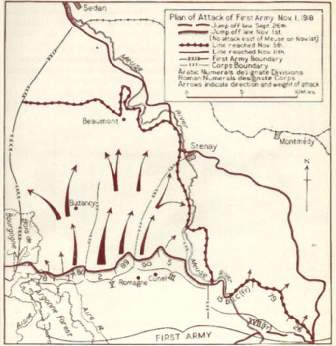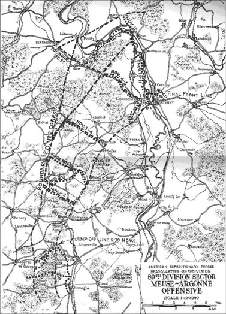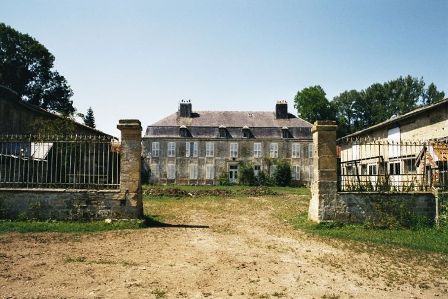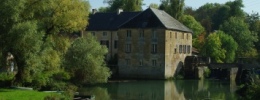Meuse-Argonne offensief - november 1914
September 26 - November 11, 1918
The Meuse-Argonne Offensive was the greatest American battle of the First World War. In six weeks the AEF lost 26,277 killed and 95,786 wounded. It was a very complex operation involving a majority of the AEF ground forces fighting through rough, hilly terrain the German Army had spent four years fortifying. Its objective was the capture of the railroad hub at Sedan which would break the rail net supporting the German Army in France and Flanders and force the enemy's withdrawal from the occupied territories.
History of the 353rd Infantry Regiment - 89th Division
CHAPTER XXIIION TO STENAY
The army line advanced rapidly during these days in early November, 1918. By evening of November 3rd the 355th Infantry (178th Brigade) was in the vicinity of Beauclair and was preparing to move on into Dieulet Forest on the following day. Even while the 178th Brigade was passing through our lines, artillery was blasting the way for the advance of the 90th Division on our right. The enemy was in full retreat. We must lose no opportunity to exploit our success.
However, during the evening, orders were received from the Fifth Corps that the First Division would send a column through our lines and that the 89th Division would be assembled in the rear. General Wright promptly asked permission to remain in the line and continue the advance, at least until his Division was in possession of Dieulet Forest and possibly the bridge-head at Laneuville. His request was granted.
 Hardly had the 353rd Infantry gathered in the vicinity of Tailly until orders were received to advance. The men of the First Battalion were busy with their shelters in the near edge of the woods just east of the town. Everybody was rejoicing in the prospect of a comfortable night. After darkness had set in, orders came to roll packs at once and be ready to move out. Many doubted their ability to move farther but soon they were on their way. The march continued through the town of Halles, over swampy fields, to a position along the road just north and east of Beauclair.
Hardly had the 353rd Infantry gathered in the vicinity of Tailly until orders were received to advance. The men of the First Battalion were busy with their shelters in the near edge of the woods just east of the town. Everybody was rejoicing in the prospect of a comfortable night. After darkness had set in, orders came to roll packs at once and be ready to move out. Many doubted their ability to move farther but soon they were on their way. The march continued through the town of Halles, over swampy fields, to a position along the road just north and east of Beauclair.
Here was an open field seeping with water. Troops of the 178th Brigade had left it shortly before. No one seemed to know the location of the front. Machine guns puttered away in all directions, and now and then distant very-lights could be seen floating through the air. Sectors were assigned to each platoon and soon the men were "digging in." This had been the battle field of the previous day. In the darkness our men stumbled over the bodies of the dead scattered about. By daylight everybody was well out of sight. Water had seeped into the miserable holes. Everyone was wet and the weather was chilly. But evening of the following day saw the kitchens located in Beauclair. Enemy shelling was not so terrific as it had been in Bantheville Woods. The First Battalion had known greater hardship even than this, so the men settled down to make the most of it.
 On the following day, November 4th, the Third Battalion, under command of Captain Postin of the Machine Gun Company, (Major Blackinton was now detailed as second in command of the regiment) also moved forward and occupied positions in the vicinity of Beauclair. The Second Battalion took up a position on the steep slope in the western edge of Beauclair Woods. Major Peatross established his P. C. near the Forgettes Chateau, generally known to the men of the regiment as the "White Chateau" because of its color. There was good protection here from artillery and the woods provided ample camouflage against aerial observation. Here at last was a chance for recuperation.
On the following day, November 4th, the Third Battalion, under command of Captain Postin of the Machine Gun Company, (Major Blackinton was now detailed as second in command of the regiment) also moved forward and occupied positions in the vicinity of Beauclair. The Second Battalion took up a position on the steep slope in the western edge of Beauclair Woods. Major Peatross established his P. C. near the Forgettes Chateau, generally known to the men of the regiment as the "White Chateau" because of its color. There was good protection here from artillery and the woods provided ample camouflage against aerial observation. Here at last was a chance for recuperation.
But the position turned out to be merely a new base of operations for the Second Battalion. In the evening of November 4th Companies "E" and "G," under command of Captain Dienst, were ordered to move up and establish combat liaison between the 355th Infantry and the 90th Division on our right. The 355th Infantry had entered Dieulet Forest near Beauclair and the 90th Division units were reported somewhere north of Halles. It was a case of hunting the other outfit in the night.
As soon as "chow" could be had, the march was begun around the point of the hill, across the swamps toward Beauclair. Captain Dienst and a party of runners had preceded on ahead to Halles and gathered such information as was available. It appeared that the troops of the 90th Division were that very evening to move forward. In Beauclair, the commander of the 355th Infantry was unable to give any idea of the locations of the troops on the right. The explanation was clear. The troops of the 90th Division had not yet moved out. But inasmuch as they had expected to advance that evening, there was nothing to do but move on toward the front. If no other troops could be located on the right, the detail could at least protect the right flank of our own Division.
 The bridges over the Wiseppe River were out. Foot-logs were thrown across in a narrow place and crossing effected in single file. In the meantime patrols scouted the woods in the general direction of Wiseppe. After a long time they reported that troops of the 90th Division had just moved to Boulain Woods near Boulain Farm (foto), about a kilometer away.
The bridges over the Wiseppe River were out. Foot-logs were thrown across in a narrow place and crossing effected in single file. In the meantime patrols scouted the woods in the general direction of Wiseppe. After a long time they reported that troops of the 90th Division had just moved to Boulain Woods near Boulain Farm (foto), about a kilometer away.
At four o'clock in the morning of November 5th, communication was established with the 355th Infantry in Dieulet Forest and the troops of the 90th Division. Patrols penetrated the woods to the Meuse River near Laneuville. The enemy had evacuated the town and were now shelling it heavily. Civilians were hurrying toward our lines over the Laneuville-Beauclair road as rapidly as they could, carting all the personal belongings they could get together in baby carriages and push carts. As the advance continued, the troops in the forward positions effected their own liaison and at 2 a.m. on the morning of November 6th Companies "E" and "G" were ordered to rejoin the Second Battalion by daybreak in Beauclair Woods.
Back in this position, considered so secure, had occurred one of the most pathetic disasters of the entire campaign. Company kitchens were in place under the fine, old trees around the "White Chateau." At about nine o'clock, November 5th, the noon meal was being prepared. Suddenly seven German planes appeared high up in the sky above them, then came the rapid succession of aerial bombs--zzing, zzing, zzing. This was the first direct aerial attack which the men had ever experienced. Before anyone could realize what was taking place the deadly bombs--at least sixteen of them--were exploding in their very midst. When the death toll was counted, it was found that eight men had been killed and more than thirty wounded. Mess Sergeants Wright of Company "G" and Jud Gooden of Company "E" were among the victims. In fact, the entire kitchen force of Company "E" had been wiped out in this disaster and the incident at Eclis Fontaine. Barry, who had been the orderly of the Second Battalion commander from the days at Funston, was another victim. Scout Murphy, whom the men had come to love and trust, died as the ambulance pulled out. No other incident in the experiences of the Second Battalion so embittered the men toward the enemy as this wanton slaughter of these unarmed men.
Chaplain Gray came back on the morning of the 6th and buried the dead soldiers in the same grave near a little clump of pines in the open. The rest of the men looked on from their positions in the edge of the woods above. Many were tired from the strain of recent days; many were suffering from dysentery and heavy colds, but this incident brought forth renewed determination to crush the forces of "schrecklichkeit."
On the afternoon of November 8th, the Second Battalion again moved forward about four kilometers to positions in Dieulet Forest just north of Beaufort. This was one of the wettest, chilliest nights of the entire campaign. Hardly had the men settled when orders came to return again to the home position in Beauclair Woods near the "White Chateau."
Such were the experiences of the men of the 353rd Infantry during these early days of November and again on November 4th the Division Commander declined relief. He was determined to drive the enemy across the Meuse. On November 6th the 177th Brigade was reported as fit for active duty and at approximately sixty per cent strength. Officers and men down in the companies realized that, in accordance with the policy of using up divisions, they were being driven to the limit. This was now the plan of winning the war. They would "carry on."
On November 9th the First Battalion received orders to move back to Tailly. For six days the men had been weathering the chilly fall rains in the funk holes just outside Beauclair. Some were stiff from the effects of wet feet and clothing. All were worn out and ready for relief. Tobacco, too, had been short, and there had been scarcely any opportunity to smoke what little they had because of orders against lights at night. Shelling had increased and some casualties were added to the list but surely this move meant a chance to get back in shape again.
The march began on the evening of the 9th. Conversation in the ranks ran something like this:
"Rest, did you say. Hell, there ain't no such thing. We are shock troops. We'll get rest when we start to pushing up poppies."
However, back in Tailly the billets and dried socks made everybody feel like he had been translated to a seventh heaven. Everybody was getting cleaned up. Some of the men were over in the little wash-house, the village laundry, so well remembered for the inscription over the door, "Gott Strafe England." Suddenly, top sergeants bawled out, "Come out of it. Get your packs ready for another move." The battalion must be ready to retrace its steps and go far beyond its old positions by evening. "A man's just naturally has to have guts, that's all," remarked one of the men as he hastily drew on his clothing to get ready for the new move.
The battalion was to stop at a point in the woods near the roadside to await orders. The men unslung packs; some unrolled their blankets to good advantage. Several hours passed and then came guides to take charge of the companies. The way led toward Laneuville. Guides gave information about the situation to the company commanders as they moved along. The Second Battalion was to relieve two companies of the 355th Infantry in Laneuville and two companies of the same regiment bivouacked just outside of the town.
Company "C" and "D" arrived in the woods just west of Laneuville late because their guides lost the way. Company "B" was billeted in Laneuville while Company "A" occupied a large dugout just beyond the railroad tracks. The whole of Company "A" together with one machine gun platoon were crowded into a dugout of three rooms. The tired men threw off their equipment to get what rest they could.
Local information indicated that the First Battalion must cross the Meuse and enter Stenay. German snipers and machine gunners were active and artillery threatened at all times. One dare not show himself outside the dugout in daylight on account of the snipers. A major and his orderly were lying at this moment down the road. They had been picked off that very afternoon. The bridges across the river had been blown up. A patrol attempting to cross the river was stopped by machine guns. They had left their leader and several dead on the banks. At this critical moment in the narration Captain Dahmke, followed by Major Blackinton, entered the dugout. Then came the news which the men had anticipated. The calm, steady voice of Major Blackinton threw a pall on all listeners as he said, "Your orders are to be in Stenay tonight."
It was hard to realize the possibility of accomplishing the mission under the conditions. The Germans occupied the city of Stenay and the high ground beyond. They were prepared to hold their positions with machine guns and artillery. Moreover, there was the river and the canal to be crossed and only one boat available. It had a carrying capacity of thirty men. On the east side of the Meuse the 90th Division was advancing from the south. They were to have taken Stenay on the 10th and to announce occupation with a rocket signal. Close observation revealed no signal, and their location was unknown. The First Battalion must drive across the river for Stenay.
Meanwhile the Second and Third Battalions were on their way to co-operate with the 90th Division troops on the east side of the Meuse river. The Second Battalion left Les Forgettes Chateau in the early evening, never to return. The march led over the high hill in the heart of Tailly Woods, through Montigny and Saulmory. Near Ville-France the engineers had constructed a pontoon bridge. Lieutenant Melvin with a patrol from Company "G" was on ahead. It seemed impossible to get definite information regarding the location of the 90th Division troops, but the battalion must be in position to advance on Stenay in the morning.
Without a moment's hesitation the men moved across the bridge in single file. The meadows between the river and the canal, on the east bank of the Meuse, were stiff with a heavy hoar-frost. Movement was necessary to keep from freezing. Finally the battalion halted near the locks on the Meuse Canal about two kilometers southeast of Mouzay.
Lieutenant Melvin reported that the town of Mouzay was filled with gas and that he had been unable to gain contact with the 90th Division troops. Major Peatross, Lieutenant Melvin, and a few runners again went forward while the men fell out along the steep banks of the canal. Some officers and a little party of men tried to kindle a fire in the lock-keeper's house. Someone had left a newspaper here. It was two days old but it gave the terms of the armistice. Everyone fully expected that fighting would continue. At 4:30 a. m. march was resumed to Mouzay where it was learned that a strong patrol had been organized to enter Stenay. Its mission was to determine the strength of the forces holding the town. The patrol did not accomplish its mission and the 90th Division did not attack in the morning.
The Second Battalion took over the abandoned German billets and proceeded to forget about the war. But hardly were the men asleep when shells began to fall into the edge of the town. There were no orders to move and no one stirred. Presently word came from the 179th Brigade Headquarters of the 90th Division that the armistice was signed. Those who were asleep were not disturbed and those who were awake found a place to sleep. The men of the Second Battalion were so nearly "all in" that they must rest before they could realize the news.
The experience of the Third Battalion was quite similar to that of the Second. Up until 2 a. m. of November 11th the Third Battalion held positions in La Haie Woods near Beauclair. At that hour, orders were received to join the Second Battalion across the Meuse River in the advance on Stenay from the south.
The march of the Third Battalion led over the flooded roads along the Wiseppe River. Dawn brought them to Wiseppe. The enemy had destroyed the bridge. It was necessary to improvise a crossing. Only one man could make his way at a time on the treacherous logs. At last the battalion reached the pontoon bridge at Ville-franche.
All was going satisfactorily until the mooring of the boats gave way. Several men fell into the cold, swift river. Difficulties could not be allowed to impede the progress. The bridge was hastily repaired and the Third Battalion followed the Second in the direction of Mouzay.
While sitting alongside the road an officer drove up and announced the news of the armistice, and gave orders to continue on to Stenay. The chief concern of the men now was to find a good place to rest.
During these hours, the officers of the First Battalion continued their efforts to find a way across the Meuse River. Lieutenant Driscoll and Lieutenant Connors had not reported back with their patrols at 3 a. m. Lieutenant Chalmer with Private Cadue was sent out. The light from a burning barrel of oil at the water's edge enabled him to locate Lieutenant Connors' patrol. No crossing could be found. When they returned Major Blackinton set out with Captain Dahmke to confirm the information of the patrols.
Lieutenant Hulen in command of "A" Company had posted sentries under cover to make observations. At nine o'clock Lieutenant Chalmer reported back that a crossing could be effected.
The high embanked road leading over to Staney had been blown out in no less than eight places, and the bridges over the river, canal, and mill-race were destroyed. Some engineers had been trying to estimate the possibilities of a crossing, but were driven away by enemy shrapnel. On the basis of this information, Company "A" was ordered to cross the river. Lieutenant Connors was to lead with the patrol, Lieutenant Chalmer was to follow with his platoon in fifteen minutes and prepare crossings. It was now 9:30 a. m.
A heavy fog hung close to the surface. Nothing was visible but the broad expanse of the water which disappeared in the haze a few yards out from the shore. Every man wished he could look beyond. Surely the enemy was waiting to open fire at the first appearance of advancing troops. But this fog that had been so disagreeable served effectively as a screen for our activities.
Nearer approach to the road showed mysterious rows of sticks driven in the ground parallel to the water's edge and at right angles to the road. These sticks stood some seven or eight feet high. Wisps of vegetation were tied about two feet from the top. Their use was apparent. Machine gunners knew the range to these sticks. They knew the intervals between the poles and could control their field of fire from right to left without being called upon to estimate it. Quietly and patiently the men worked their way forward. The gaps which had been blown in the embanked road were from fifteen to thirty feet across. Water rushed through the openings below. It was necessary to make a steep descent on one side, pass over the debris in the bottom, and then make the steep ascent on the other side to continue toward Stenay. After crossing five of these gaps, the bridge which spanned the Meuse loomed into view. One long girder lay suspended from its base on one side across the gap. Just beyond was the bank of the canal, covered with wire entanglements. The bridge across the canal was out, but fifty yards above lay the ruins of the lock-gates which afforded a passage. The mill-race was still to be crossed. Its bridge was completely down. Heavy timbers were soon adjusted into a foot-log. Only one man could cross at a time, but in the event of shelling this formation was highly desirable.
The thought of machine gun fire was oppressive. On the battlefield there was a chance of flanking the enemy but here the men were at the mercy of the enemy. We could do nothing but move ahead. Safely across, the patrols reported that they were ready to leave. Lieutenant Hulen with the slightest trace of a smile on his worn face said, "It is reported that there will be no firing after eleven o'clock, but don't throw away your equipment!"
At ten o'clock Lieutenant Connors reported the occupation of Stenay in the following brief message:
"Private Gielow defeated for mayor of Stenay by three votes."
He immediately set about getting the French civilians out of their cellars and rounding up the few Germans who remained behind. The town was still being bombarded in the southern section, but the patrols met no resistance in their operation.
At 10:30 a patrol from the 90th Division entered the town from the south. Lieutenant Connors notified its leader, a Lieutenant Quinn, that the town of Stenay was in possession of the First Battalion, 353rd Infantry, 89th Division. Before 11 a. m., armistice hour, all of Company "A" had made their way across and a line of outposts was established on the heights above the town. There were no casualties, but the mental strain and physical exertion had been terrific. The men of the First Battalion had earned the right to the good billets of Stenay for their regiment.
NATIONAL ARMY USA - SEPTEMBER, 1917 - JUNE, 1919
CAPT. CHARLES F. DIENST -Historian 353rd Infantry
FIRST LIEUT. CLIFFORD CHALMER - Historian First Battalion
FIRST LIEUT. FRANCIS M. MORGAN - Historian Second Battalion
FIRST LIEUT. CHARLES O. GALLENKAMP - Historian Third Battalion
FIRST LIEUT. LLOYD H. BENNING - Historian Headquarters Company
FIRST LIEUT. HAROLD F. BROWN - Historian Supply Company
FIRST LIEUT. MORTON S. BAILEY -
SECOND LIEUT. WILLIAM J. LEE - Historians Machine Gun Company
Published By - THE 353RD INFANTRY SOCIETY
Copyright: Regimental Society, The 353rd Infantry - 1921
PRINTED AND BOUND BY THE EAGLE PRESS - WICHITA, KANSAS
http://www.kancoll.org
